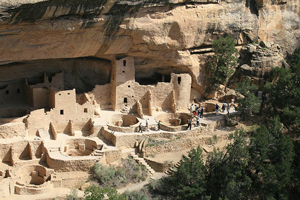
The “pot-hunting” culture of the Southwest dates back to the 1800s, when a Colorado ranching family began exploring and excavating the ruined cliff dwellings of the Anasazi, an ancient civilization that flourished centuries ago.
Richard Wetherill and his brothers discovered entire homes filled with decorated pottery, jewelry, tools, sandals and finely woven baskets dating from about 600 to 1300. Thousands of grave sites, where the dead were wrapped in blankets and buried with their most valuable possessions, also were discovered.
The findings, and the archaeological treasures the Wetherills brought back from their expeditions, drew national and international attention – and launched a lucrative trade in Indian artifact collecting that has persisted, legally and illegally, to this day.
Attitudes were different a century ago, when archeologists trained people to dig and the University of Utah paid locals $2 for an ancient pot. But the wholesale ransacking of ancient puebloan ruins and graves – whole skeletons, called mummies, were repeatedly dug up – alarmed conservationists.
In 1906, the Antiquities Act was signed by President Theodore Roosevelt, establishing the first legal protections for cultural and natural resources in the United States. The law also designated Mesa Verde in Colorado, the largest and most spectacular site, as a national park.
But enforcement was practically impossible, and illegal digging continued throughout the vast desert cliffs and mesas of the Four Corners region. Other laws were passed over the years, including the Archaeological Resources Protection Act of 1979, which greatly increased the penalties for looting on federal and tribal lands.
Defendants in recent raids across the Southwest were charged with violations of this law, and of the Native American Graves Protection and Repatriation Act, which calls for human remains, cultural and sacred objects to be repatriated to tribes.
The 1990 act, passed after Native Americans testified in Congressional hearings that the spirits of their ancestors would not rest until they were reburied, required museums and universities around the country to inventory all items considered sacred or cultural and to return hundreds of thousands of skeletons.
While the tribes say these laws are essentially a civil rights issue, righting the wrongs of a century of desecration, dealers argue that NAGPRA is vague and unfair. In Santa Fe, some dealers had artifacts seized which they insist had been openly traded or exhibited in collections for decades.
Enforcement is further complicated by the fact that it is legal to excavate artifacts on private property, except burial sites. It is also legal to purchase items from others who have obtained them lawfully or by inheritance.
For all who complain about the laws, there are many who think the problem isn’t the rules, but long-standing attitudes about collecting.
“The information is out there about what is allowed and what is not,” said Alan Downer, of the Navajo Nation’s historic preservation department, which works with museums to properly return artifacts. “There are ways to acquire these things legally. But people do not have the right to go onto federal or Indian land and take something that does not belong to them.”
Copyright 2009 Associated Press. All rights reserved. This material may not be published, broadcast, rewritten, or redistributed.
AP-ES-10-04-09 0004EDT

